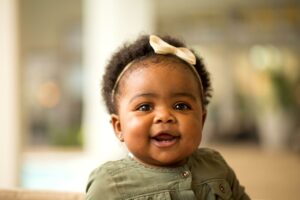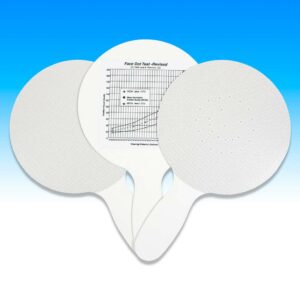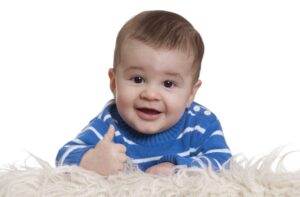But my baby’s eyes get checked at birth, right?
Yes, the eyes are a part of the pediatrician’s examination at birth. Many ocular problems are caught at that time. However, problems with vision development are not always apparent at birth. This is perhaps the best answer to the “Why?” question. Six-twelve months of age is when the visual development of an infant begins to take off and hence an ideal time for the comprehensive vision exam.
One of the most common vision development problems.
 Amblyopia, sometimes referred to as “lazy eye,” is perhaps the most common problem caused by lack of proper vision development. There can be an abnormal eye turn sometimes associated with amblyopia, which may be noticeable to the parents, causing them to seek medical attention. However, not all cases of amblyopia have an eye turn.
Amblyopia, sometimes referred to as “lazy eye,” is perhaps the most common problem caused by lack of proper vision development. There can be an abnormal eye turn sometimes associated with amblyopia, which may be noticeable to the parents, causing them to seek medical attention. However, not all cases of amblyopia have an eye turn.
In this situation, parents do not detect any reason to be concerned, and only a complete vision exam will reveal amblyopia.
Because vision is so integral to development and learning, amblyopia can cause poor depth perception, constant eye turn, postural imbalances, and contribute to other developmental problems and learning impairments. As a general rule, when amblyopia is caught early, the prognosis is much better for achieving optimal vision development and function.
InfantSEE
 Your local optometrist can perform your infant’s first comprehensive eye exam. Some optometrists are more comfortable than others at treating children and infants. If your optometrist is not comfortable, they may know someone who is, or you can find an optometrist near you that participates in the InfantSEE program and will do the infant vision exam for free between 6-12 months of age. Go to infantsee.org to find a provider near you.
Your local optometrist can perform your infant’s first comprehensive eye exam. Some optometrists are more comfortable than others at treating children and infants. If your optometrist is not comfortable, they may know someone who is, or you can find an optometrist near you that participates in the InfantSEE program and will do the infant vision exam for free between 6-12 months of age. Go to infantsee.org to find a provider near you.
Examine my infant’s eyes? How?
 Often the “Why?” question leads to the “How?” question. How does an eye doctor examine an infant’s eyes when they cannot respond to our favorite question, “Which is better? One…or…two…?”
Often the “Why?” question leads to the “How?” question. How does an eye doctor examine an infant’s eyes when they cannot respond to our favorite question, “Which is better? One…or…two…?”
Your infant’s limited abilities to communicate require different testing methods to gather eye health and vision information. Each optometrist uses the tests and methods they are most comfortable with and most effective with. I want to share a few I like to use including: retinoscopy, Face Dot Visual Acuity, and yes, toys!
Yep, infant eye exams look different than the one you had.
Retinoscopy is a special method of testing for a glasses prescription that allows your eye doctor to shine a uniquely shaped light into your baby’s eyes and observe the reflex off the retina inside of the eye. The color, luster, brightness, and movement of the reflex indicate to the trained viewer what lens combination is required to provide the clearest vision in that eye.
So, all your infant has to do is look at the light–which most babies are happy to do! That’s easy!
Now that your eye doctor knows whether or not your baby needs glasses, it is necessary to test the visual acuity of your sweet, little one. Visual acuity is the test that determines if you can see 20/20 or not. Believe it or not, sometimes infants cannot see 20/20 even through the perfect glasses prescription. This is precisely why amblyopia can be so devastating if not found and treated as early as possible.
Different is good.
 My chosen alternative visual acuity test is the Face Dot test, because babies will probably just smile at the eye chart on the wall, if at all. This test works because you love your baby and your baby loves looking at your smiling face! The Face Dot Test has simple paddles to present to your baby–one in the shape of a smiling face and the other a blank target. Because your baby much prefers to look at a smiley face, the two targets can be slowly separated in front of the infant while observing the eyes to confirm your child is choosing to look at the target with the smiling face. This is repeated multiple times while incrementally moving farther away. The developers of the test have determined the equivalent visual acuity that corresponds to the distance where the baby is just unable to see the smiley face anymore.
My chosen alternative visual acuity test is the Face Dot test, because babies will probably just smile at the eye chart on the wall, if at all. This test works because you love your baby and your baby loves looking at your smiling face! The Face Dot Test has simple paddles to present to your baby–one in the shape of a smiling face and the other a blank target. Because your baby much prefers to look at a smiley face, the two targets can be slowly separated in front of the infant while observing the eyes to confirm your child is choosing to look at the target with the smiling face. This is repeated multiple times while incrementally moving farther away. The developers of the test have determined the equivalent visual acuity that corresponds to the distance where the baby is just unable to see the smiley face anymore.
Visual acuity…check!
Doable? Oh, yeah!
 I think you can see now that an infant eye exam takes some creativity but is definitely doable. More than doable, it’s fun when we break out the toys! Keeping the baby’s attention is key. Little finger puppets and colorful lights are the type of things that I use. On that note, I have a couple suggestions to prepare your baby for the best exam possible. Make sure your infant is fed and schedule the exam at a time when your baby is typically most happy and alert.
I think you can see now that an infant eye exam takes some creativity but is definitely doable. More than doable, it’s fun when we break out the toys! Keeping the baby’s attention is key. Little finger puppets and colorful lights are the type of things that I use. On that note, I have a couple suggestions to prepare your baby for the best exam possible. Make sure your infant is fed and schedule the exam at a time when your baby is typically most happy and alert.
What’s the hold up?
I have been doing infant eye exams for over 10 years now. And I am confident that one of the best gifts you can give your precious baby is to ensure vision is developing optimally. Please allow me or another InfantSEE provider to share in this wonderful gift by performing your infant’s eye exam for free. Now, there’s no reason not to.

Destin D. Whipple, OD
desertfamilyeyes.com


